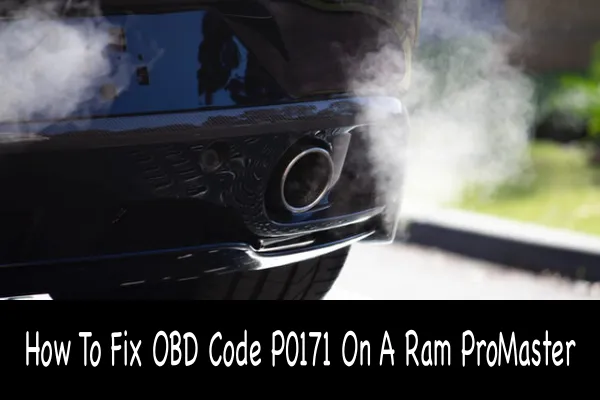OBD code P0171 indicates a serious issue with the fuel/air ratio entering the first cylinder bank on your Ram ProMaster – i.e. the side with the #1 cylinder. This generally means that you've got a leak somewhere that's keeping the engine from getting enough fuel.
What causes OBD code P0171 on the Ram ProMaster?
Causes are varied but the issue is usually somewhere on the following list:
- A (typically faulty) fuel pump working at below-standard levels
- A vacuum leak somewhere downstream of the carburetor
- A faulty or dirty MAF (Mass Air Flow) sensor
- A faulty or dirty O2 (Oxygen) sensor
- A damaged or otherwise faulty fuel injector(s)
- A damaged or faulty fuel-pressure regulator.
What symptoms are associated with code P0171?
Symptoms are pretty wide-raning as well and depend heavily on how severe the problem is.
If the fuel/air ratio is a only little weak, you will encounter:
- Reduced – potentially severely reduced – engine power.
- A lit Malfunction Indicator Lamp or "Check Engine Light"
- Hesitation or rumbling from the engine.
- The engine may take longer to start
If the fuel/air ratio is far too lean, you're more likely to encounter the following symptoms:
- Unexpected engine shutoff / the engine dying
- Refusal to start
- (Eventually) a damaged catalytic converter
How to diagnose code P0171 on a Ram ProMaster:
- First, check for other trouble codes with an OBD scanner like this one from BlueDriver. This will help you ensure you've got a full picture of the issues you're facing from P0171 and other codes before you proceed.
- Once you've confirmed that P0171 is present & you're aware of any other issues present, continue by using a vacuum gauge as demonstrated in the video below. We recommend this model off Amazon, but any old vacuum gauge will do. Keep in mind that vacuum leaks are typically only audible when the engine is off. You'll want to listen for a hissing sound & trace it back as best you can.
- The fuel pressure sensor and MAF sensor (mass air flow) also need to be checked with a fuel pressure gauge set like this one. You'll want to make sure that the readings from your diagnostic tool line up with the readings from the MAF sensor & fuel pressure sensor. If they don't, it's a faulty sensor you're dealing with.
- The vacuum, fuel pressure, & MAF readings from the engine need to be within the manufacturer specs. The root of this trouble code will likely be discovered during those three tests, but if not…
- The problem is probably a sensor. Replace it as directed by the manufacturer.
- If all else fails, you're probably looking at an expensive repair to the PCM (Powertrain Control Module).
Things to watch out for when diagnosing & repairing code P0171 on the Ram ProMaster:
- As always, technical service bulletins are your friend. It's an easy google search to find the bulletins for your vehicle and they often contain information invaluable to a repair.
- If you think you've got an issue with your MAF sensor, consider cleaning it with MAF cleaner spray first – it costs $20 and might save you hundreds in parts & labor.
What specific repairs are involved in fixing OBD code P0171?
Consider the following fixes depending on what you learned while diagnosing your issue.
- Replace the fuel pressure regulator
- Replace one (or multiple) fuel injectors
- Clean your MAF (Mass Air Flow) sensor
- Replace your MAF sensor
- Replace the fuel pump
- Examine your engine for vacuum leaks (again, listening closely while the engine is off)
- Replace your fuel filter if nothing else is working
Is code P0171 serious?
In short, yes. If you've been driving around with P0171, your engine's going to start having progressively bigger issues. It might start with a slight knocking or a little less power when you put your foot down, but it'll turn into needing a new $3000 catalytic converter before you realize it.
Not only that, but even in a really minor case you'll lose out on a lot of engine power & face terrible fuel efficency. We highly recommend you get this fixed quickly whether you do it or someone else does.
Hopefully this article answers most of your questions.
Until next time! The Car Tire Reviews team
We'd like to remind you that this article is for informational purposes only & that your vehicle is your responsibility
